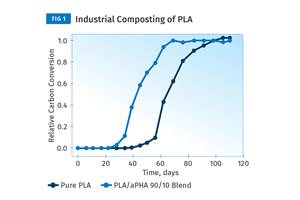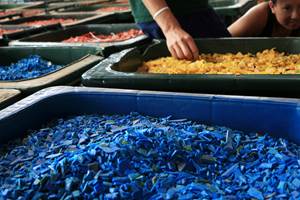New Family of Bioplastics Boast Property Retention as well as Degradability and Recyclability
U.K. and U.S university research team have developed both a stretchable rubber like plastic as well as a tough but ductile one.
Last year, I reported on the development of a type of polyester biomaterial, designed for use in soft tissue repair or flexible bioelectronics, that a team of researchers from U.K.’s University of Birmingham and U.S.’s Duke University had succeeded in ‘fine tuning’ to enable both the rate at which it degrades in the body and its mechanical properties.
We were recently contacted about another collaborative development from the two universities, this one involving a research team that created a new family of polymers from sustainable sources that reportedly retain all the same properties as typical thermoplastics, but are degradable and mechanically recyclable.

The researchers used sugar-based starting materials to make two new polymers, one which is stretchable like rubber and another which is tough but ductile, like most commercial plastics. More specifically, they used isoidide and isomannide compounds as building blocks, both of which are made from sugar alcohols and feature a rigid ring of atoms.
The team found that the isoidide-based polymer, showed a stiffness and malleability similar to common plastics, and a strength that is similar to engineering resins such as nylon 6. Although isoidide and isomannide only differ by the 3D spatial orientation of two bonds, known as stereochemistry, the isomannide-based material was found to have similar strength and toughness but also showed high elasticity, recovering its shape after deformation.
Also notably, it was shown that the materials retained their excellent mechanical properties following pulverization and thermal processing--the usual method for mechanically recycling plastics.
The researchers used cutting-edge computational modelling to simulate how the polymer chains pack and interact to produce such different polymer properties. The unique 3D shapes of the sugar derivatives facilitate different movements and interaction of the long chains causing the huge difference in physical properties that was observed.
By creating copolymers that contain both isoidide and isomannide units, the team found that they could control the mechanical properties and degradation rates independently of one another. As such, this system reportedly opens the door to using the unique shapes of sugars to independently tune the degradability for a specific use without significantly altering the properties of the material.
The chemical similarity of these bioplastics means that, unlike a lot of current commodity plastics, they can be blended together to yield materials with comparable or improved properties.
Said Josh Worch, from Birmingham’s School of Chemistry, and a co-author in the research, “The ability to blend these polymers together to create useful materials, offers a distinct advantage in recycling, which often has to deal with mixed feeds”.
Connor Stubbs, also from Birmingham’s School of Chemistry, said, “Petrol based plastics have had decades of research, so catching up with them is a huge challenge. We can look to the unique structures and shapes that biology have to offer to create far better plastics with the same expanse of properties that current commercial plastics can offer”
Noted Duke University professor Matthew Becker said, “Our findings really demonstrate how stereochemistry can be used as a central theme to design sustainable materials with what truly are unprecedented mechanical properties.”
Professor Andrew Dove, who led the research team from Birmingham, said this study really demonstrates what is possible with sustainable plastics. “While we need to do more work to reduce costs and study the potential environmental impact of these materials, in the long term it is possible that these sorts of materials could replace petrochemically-sourced plastics that don’t readily degrade in the environment.”
A joint patent application has been filed by University of Birmingham Enterprise and Duke University. The researchers are now looking for industrial partners who are interested in licensing the technology.
The study, Sugar-Based Polymers with Stereochemistry-Dependent 2 Degradability and Mechanical Properties, is published in the Journal of the American Chemical Society, and is available at: https://doi.org/10.1021/jacs.1c10278
Related Content
ICIS Launches: Ask ICIS Generative AI Commodities Assistant
Said to be the first of its kind, this AI assistant will enhance access to ICIS’ intelligence and insights for the energy and chemical markets.
Read MoreHow to Optimize Injection Molding of PHA and PHA/PLA Blends
Here are processing guidelines aimed at both getting the PHA resin into the process without degrading it, and reducing residence time at melt temperatures.
Read MoreBlend Amorphous PHA with PLA to Improve injection Molded Part Properties
Adding aPHA to PLA can boost a range of mechanical properties and expedite composting. Here are the details as well as processing guidelines for injection molding the blends.
Read MoreAt NPE2024, Follow These Megatrends in Materials and Additives
Offerings range from recycled, biobased, biodegradable and monomaterial structures that enhance recyclability to additives that are more efficient, sustainable and safer to use.
Read MoreRead Next
Beyond Prototypes: 8 Ways the Plastics Industry Is Using 3D Printing
Plastics processors are finding applications for 3D printing around the plant and across the supply chain. Here are 8 examples to look for at NPE2024.
Read MoreFor PLASTICS' CEO Seaholm, NPE to Shine Light on Sustainability Successes
With advocacy, communication and sustainability as three main pillars, Seaholm leads a trade association to NPE that ‘is more active today than we have ever been.’
Read MoreLead the Conversation, Change the Conversation
Coverage of single-use plastics can be both misleading and demoralizing. Here are 10 tips for changing the perception of the plastics industry at your company and in your community.
Read More


























